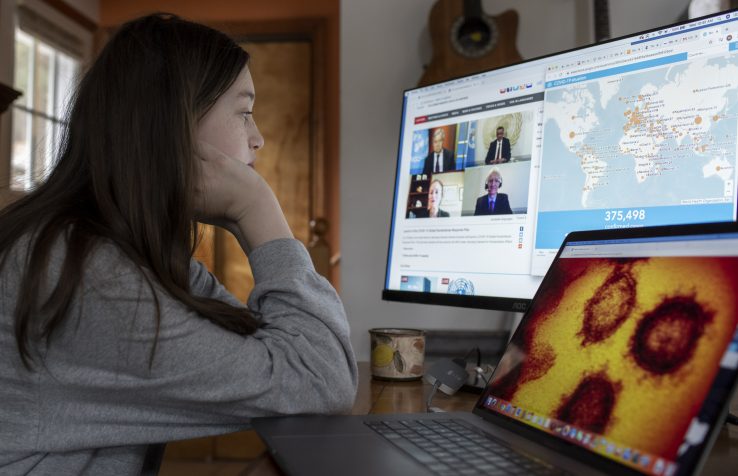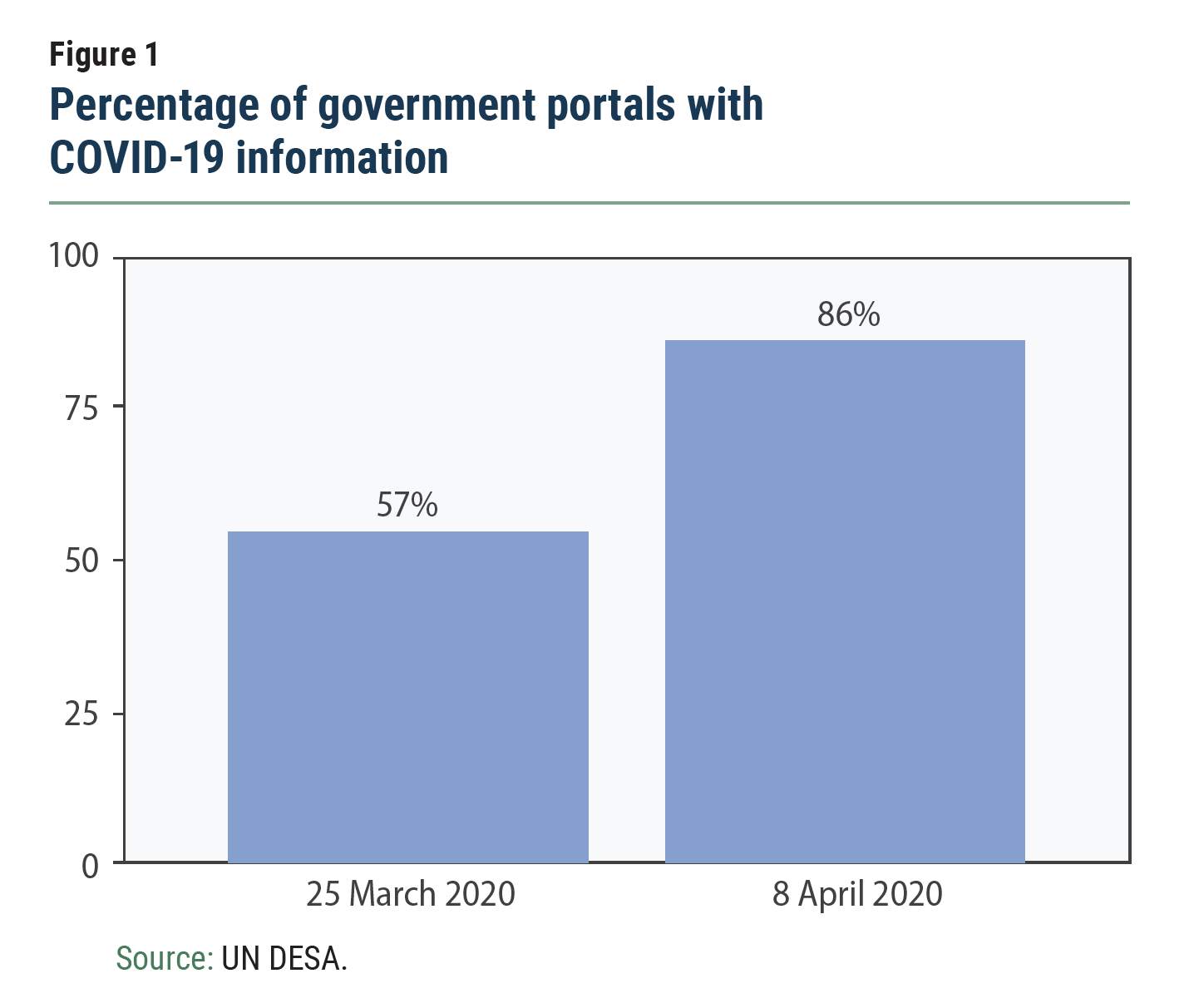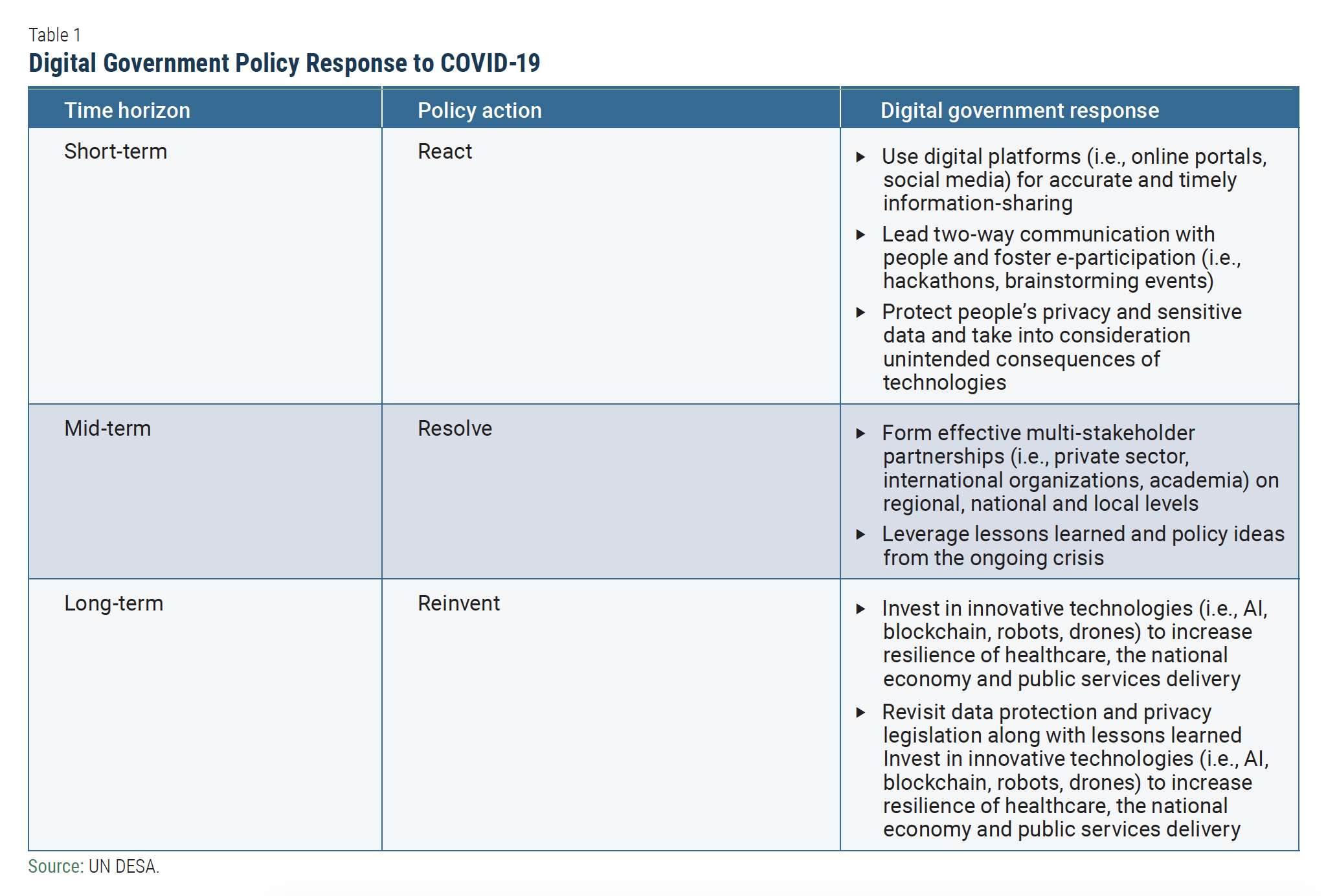
UN/DESA Policy Brief #61: COVID-19: Embracing digital government during the pandemic and beyond
Sharing information
It is vital for governments to provide accurate, useful and up-to-date information to people, particularly during times of crisis. During the COVID-19 pandemic, governments started providing information on their national portals, mobile apps or through social media platforms. A review of the national portals of the 193 United Nations Member States showed that by 25 March 2020, 57 per cent (110 countries) have put in place some kind of information on COVID-19, while around 43 per cent (83 countries) did not provide any information; but a further analysis showed that by 8 April 2020, around 86 percent (167 countries) have included information and
guidance about COVID-19 in their portals (Figure 1).
 The most basic form of information found on some national portals is some media coverage informing people about the outbreak, travel restrictions, practical guidance on protection, and governmental response. A slightly more advanced way seems to be having a dedicated portal or section about the outbreak—usually with a custom domain name. Governments, as the first custodian of related data of COVID-19, have also started publishing statistics about the outbreak. These include total number of cases in a country, total fatalities, as well reporting of cases by jurisdictions. Reliable information from governments helps people make informed decisions about their daily routines, build public trust as well as enables public authorities to act decisively to flatten the curve.
The most basic form of information found on some national portals is some media coverage informing people about the outbreak, travel restrictions, practical guidance on protection, and governmental response. A slightly more advanced way seems to be having a dedicated portal or section about the outbreak—usually with a custom domain name. Governments, as the first custodian of related data of COVID-19, have also started publishing statistics about the outbreak. These include total number of cases in a country, total fatalities, as well reporting of cases by jurisdictions. Reliable information from governments helps people make informed decisions about their daily routines, build public trust as well as enables public authorities to act decisively to flatten the curve.
The COVID-19 crisis has also brought new needs for digital government services and more demand on existing services. Developers in governments were mobilized and engaged in designing new apps and services to help in the fight against COVID-19. Some of these new services include delivering food and other essential items to those most in need by optimizing the entire supply chain via digital government services. Some Member States recorded an increase in the usage of online services such as digital ID and digital signature, due to the spikes in applications for unemployment and other social benefits.
During the COVID-19 pandemic, there has also been a wave of fake news and viral hoaxes. Users with ill objectives or inadequate knowledge contribute to the spread of fake news and create further panic in society. Thousands of COVID-19 scam and malware sites have emerged on a daily basis, such as the sale of counterfeit surgical masks, fake self-testing kits and so on. The World Health Organization has categorized this as the secondary issue of an infodemic “an overabundance of information—some accurate and some not—that makes it hard for people to find trustworthy sources and reliable guidance when they need it.” In response, some governments have launched response units or campaigns to coordinate the fight against online misinformation about COVID-19.
Engaging people
Involving civil society organizations, businesses, social entrepreneurs and the general public in managing the COVID-19 pandemic and its aftermath can prove to be highly effective for policy- and decision-makers. Online engagement initiatives led by governments can help people cope with the crisis as well as improve government operations. In a crisis situation, it becomes more important than ever to reach out to vulnerable groups in society, respond to their needs and ensure social stability. Engaging with civil society allows governments to tackle socio-economic challenges in a more productive way that leaves no one behind.
Government-organized hackathons is one way of engaging people in finding innovative solutions to economic, social and technological challenges of the COVID-19 pandemic. Public officials, together with software developers, civil society and social entrepreneurs can collectively search for new solutions to, for example, the lack of medicines and protective medical equipment, the shortage of health personnel (i.e., in hospitals or food banks), the issue of food hoarding, or the deteriorating mental health of people as a result of social isolation. In one initiative, local governments in China have launched a city Health QR Code service through the government service platform, which is based on the health data declared by residents or returned workers. The code could be applied by logging in through multiple public mobile platforms. Local governments verify the personal declaration information with health, civil aviation, railway and other related data, and issue an e-certificate of personal health information. In the Republic of Korea, in addition to interviewing, officials use location data from mobile phones, credit card transaction records and CCTV footage to trace and test people who might have recently come into contact with an infected person. Detailed maps are also published showing movements of infected people, encouraging others who thought they might have been in contact with an infected person to get tested.
Many governments have further utilized social media platforms to connect with people. Some also have partnered with influencers to disseminate accurate information about the COVID-19 outbreak, and to counter harmful misinformation. There has been a particular focus on engaging with youth and children, who are very vulnerable to fake news and might suffer from the burden the COVID-19 crisis put on parents’ social, economic and mental well-being. For example, Norway’s Prime Minister Erna Solberg held an online press conference with a Q&A session specifically for kids to help ease their fears. During COVID-19, open data and e-participation could help build public trust in government crisis response measures and support vulnerable groups in society.
Establishing multi-stakeholder partnerships
Governments often lack the financial and human resource capabilities to quickly and efficiently develop digital tools that can support people during a crisis situation. Therefore, building partnerships with private technology companies, social entrepreneurs or other national and international organizations, can represent an effective way for governments to make use of existing technologies to meet the needs of people and soften the impact of the crisis on their lives.
Public authorities have started cooperating with a variety of stakeholders during the COVID-19 outbreak. For example, the United States Government issued a call for action to key industry stakeholders and artificial intelligence experts to develop new text and data mining techniques that can help the scientific community answer high-priority questions related to COVID-19. This platform can help speed up research and support with guidance on diagnosis, treatment and management of infected patients globally, including in developing countries that have more limited resources.
Partnerships between governments, private sector and international organizations can also be crucial to maintain services for mission-critical communications and to ensure greater connectivity. The International Telecommunication Union (ITU) has launched a platform to assist national policymakers, regulators and industry stakeholders to ensure that networks are kept resilient and telecommunication services are available to all in order to prevent further aggravation of digital divides during the COVID-19 crisis. In some countries, the Internet providers have committed to maintaining network capacity and services for critical government functions, especially hospitals and emergency calls, and to improving the dissemination of information to the public, including via SMS text alerts. In the same way, the European Commission together with the Body of European Regulators of Electronic Communications (BEREC) has launched a special reporting mechanism to monitor Internet traffic in each Member State and ensure connectivity.
The COVID-19 pandemic has also strained the supply chain for medical supplies. Demand for medical equipment has exponentially increased, creating shortages, often exposing medical personnel to greater risks. To address the problem, many private companies partnered with government agencies to develop health apps that help people, hospital staff and medical practitioners to monitor, analyse, and source critical medical equipment such as ventilators, face masks, gloves and protective gear in real time.
Digital platforms have been deployed to help with community-driven contact tracing of patients that tested positive. Singapore was one of the first countries to implement contact tracing technology with its TraceTogether app during the current health crisis. The contact tracing apps use the bluetooth feature of one’s mobile phone to anonymously save data of other users with whom one has crossed paths. Once a person’s encounter becomes infected, the user receives a notification, which allows for immediate self-testing or self-isolating. Innovative apps such as these have been developed by many different private companies and supported government attempts to contain the number of infections. There were also some concerns that some app stores restricted the wide distribution of these apps in some cases due to their high battery usage or sometimes due to privacy or data protection concerns. Effective and timely public-private partnerships are especially critical during these times since the applications only provide results with a large user-base.
Partnerships with the private sector in supporting governments have shown positive effects on the fight against the outbreak. However, it is necessary to address the potential breaches of privacy and human rights concerns that their implementation might entail. Prioritizing anonymization while aggregating personal information, the use of geolocation, as well as the access to medical records is important to protect personal data privacy. Policymakers need to take into consideration the principle of minimization and limited collection, retention and sharing of personal data to what is absolutely necessary and rationally linkable to the purpose of overcoming the health crisis to prevent surveillance misuse and violation of data privacy.
Accelerating the implementation of innovative digital technologies
Since the crisis has put public services under stress, governments are urged to deploy effective digital technologies to contain the outbreak. Most innovative quick-to-market solutions have stemmed from the private sector. However, the crisis has exposed the need for government leadership in the development and adoption of new technologies such as artificial intelligence (AI) and robotics to ensure an effective provision of public services.
AI-powered technology has proven to be beneficial for the provision of health care services when emergency lines outpaced capacity. During the outbreak, many people have turned to self-checks for symptoms and accessed “virtual doctors’’ through telemedicine to get medical advice. Multilingual chatbots offered solutions in overcoming language barriers, accessing information and communicating with health practitioners. 3D printing technologies have been adopted to produce replacement valves for reanimation devices, and protective medical face shields to address the shortage. Robots and drones have been effective in providing security and sanitation thus reducing staff exposure to risk. Patrol robots using facial recognition and thermal cameras are deployed at airports and public places to scan crowds and identify potentially infected people. Sterilization robots equipped with ultraviolet lights have been helpful to disinfect hospitals and contaminated areas. Other robots monitor vital parameters from medical devices or allow patients to communicate remotely with the nurses. Governments are also using drones with similar technologies to monitor streets, deliver medical supplies or disinfect public spaces.
The efforts in developing digital government strategies after the COVID-19 crisis should focus on improving data protection and digital inclusion policies as well as on strengthening the policy and technical capabilities of public institutions. Even though public-private partnerships are essential for implementing innovative technologies, government leadership, strong institutions and effective public policies are crucial to tailor digital solutions to countries’ needs as well as prioritize security, equity and the protection of people’s rights. The COVID-19 pandemic has emphasized the importance of technology, but also the pivotal role of an effective, inclusive and accountable government.
Conclusion
The COVID-19 pandemic is forcing governments and societies to turn toward digital technologies to respond to the crisis in the short-term, resolve socio-economic repercussions in the mid-term and reinvent existing policies and tools in the long-term (see Table 1). Navigating through these challenging times requires governments to adopt an open government approach and to use digital communication channels to provide reliable information on global and national COVID-19 developments. E-participation platforms can represent useful tools to engage with vulnerable groups online and to establish digital initiatives to collectively brainstorm for policy ideas to critical social and economic challenges.
Effective public-private partnerships, through sharing technologies, expertise and tools, can support governments in restarting the economy and rebuilding societies. Developing countries, in particular, will need international cooperation and support in mitigating the crisis. Therefore, regional, national and local project-based collaborations with private sector companies, international organizations and other stakeholders are necessary. In the long-term, governments need to accelerate the implementation of innovative digital technologies such as AI-powered technology, blockchain, and drones. Investments in these technologies can tremendously support the future resilience of the health economy and the public services delivery.


Follow Us